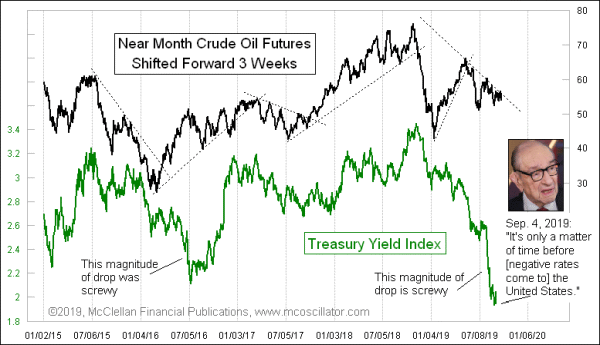
Back on July 10, I wrote in a Chart In Focus article that there was an "Upturn Ahead for T-Bond Yields." And we got a small upturn then. But that small upturn in yields was more than eclipsed by a huge drop in bond yields to historic lows, as U.S. yields were affected by the rest of the world's bond markets going mad.
Several countries' sovereign debt instruments are trading at negative yields, meaning that you pay for the privilege of someone else holding your money for you for years. And so, with investors looking around trying to find somebody to pay them anything, that has pulled down U.S. yields in sympathy.
Crude oil's 3-week leading indication had said that we should expect yields to fall somewhat in August, but it was nothing like the magnitude of what actually transpired. So what we have is a situation where bond yields have danced the right dance steps, but with a magnitude that is not at all what was choreographed.
We have seen this before. Back in June-July 2016, there was another big yield drop, almost as big as this one, that went against what crude oil's leading indication had said should happen. What happened afterwards was that bond yields worked extra hard to steer themselves back out of the ditch, and so we got a larger-than-called-for up move in bond yields. That should be the outcome this time as well.
And, just coincidentally, we had former Federal Reserve Chairman Alan Greenspan on CNBC Sept. 4 stating that he thought negative bond yields are coming soon to the U.S., in addition to other countries. That is just the sort of comment that we see throughout history as marking the top tick or bottom tick of a move.
And as that is happening, crude oil prices stand poised to break an important declining tops line. Such lines tend to matter a lot in crude oil prices. So, assuming that crude oil prices break the declining tops line and start trending higher, that is going to create additional pull higher for long-term bond yields.
